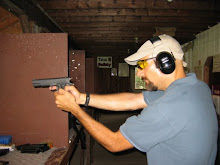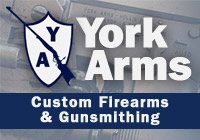Installation. Again, one of the significant advantages of the Crimson Trace Laser Sight grips is the simple installation. Step 1. Remove old grips. Step 2. Insert batteries into CT grips. Step 3. Install CT grips on handgun. If you can swap out grips on a handgun, you can install Crimson Trace Laser sight grips. I think it took maybe five minutes to install the grips on the Colt, and four of those minutes were spent locating the right allen wrench for the grip screws...
Activation. The Colt was, for me, the most intuitive Laser Sight grip. The P226 grip was just a fraction off for my grip and took effort to re-adjust when picking the gun back up - not a fault of the Crimson Trace Laser Sight grips, just how my hand interacted with the control on the P226 grips. The Smith & Wesson J-frame Laser Sight Grip was fine, but because of the small, two-fingered grip inherent to the small-framed revolver, what's considered a "normal" grip really doesn't apply.
The Colt was all different - it was just plain perfect. Pick it up, squeeze the grip naturally to engage the grip safety, *poof*, on comes the laser. Left- or right hand, it didn't matter - every single time I picked up the Colt, the laser turned on. Left-handed actually works a hair better because the trigger finger doesn't impinge the laser beam when indexed along the frame.
Shooting. Here, a picture is worth 1,000 words:

Respectable
That's two magazines at 25 feet shot rapid-fire, magazine change performed as rapidly as possible. 10 out of 14 shots can be covered by my fist. For a defensive handgun shot by an inexpert shooter, that's pretty decent - and it would be better still if I could hold the $%^*ing thing still. One of the things I noticed with the laser sight in general is that it is not a panacea for poor shooting form - if you have trouble keeping the front sight on target, you're going to have trouble keeping the laser dot on target, too. That's not a fault of the CT grips, but of the shooter...
I'll make no qualms about it - the Crimson Trace Laser Sight grips on my Colt are my favorite of the three CT grips. The activation was second nature; there was minimal correction needed on the point of aim; and the laser sight itself lent to competent, confident rapid-fire shooting owing to the fast target acquisition made possible by the laser sight.
Crimson Trace Laser Sight grips - an excellent addition to any defensive firearm.
That is all.







6 comments:
I'll second your opinion that CT lasergrips are an excellent addition to a defensive hand gun.
I have CT lasergrips on my three concealed carry firearms. Two J frames & a Kimber compact stainless II. (Officers frame, 4" barrel)
The oldest is over 5 years old. Never a problem, hiccup or anything but dependable service. Change the batteries once a year & you're GTG.
Jay, the biggest problem I noticed with the Crimson Trace grips that came with my S&W1911 was that the lens got quickly gunked up with residue from shooting... and it was a royal pain in the arse to try and clean it. You could see a lot of "spatter" (don't know what else to call it!) when you tried using the laser after only 2-3 mags worth - bits of light all over the target and not just at the center. Very distracting, to say the least.
How was your eval unit with respect to this? How easy was it to clean the lens after shooting? (the recommended method from the manual - a q-tip, IIRC - wasn't terribly effective for me).
Ross,
I didn't notice any appreciable fouling of the laser after ~ 75 rounds (and I was shooting pretty dirty ammo) on the last session; in fact, I don't believe I've cleaned the lens yet after ~ 250 rounds.
Isopropyl alcohol on the end of a Q-tip takes care of gunky laser sights (the LaserMax units, being at the end of the gun where the stuff comes out, get pretty fouled after an extended session).
I didn't notice any light-scattering on any of the units I tested; the J-frame would be the most likely suspect there given the short barrel and LSWC reloads I was shooting.
Now if they would just make one for my Smith M-39... The one on my P3AT is a real hoot.
I consider the laser being blocked by your trigger finger when it's not on the trigger to be a feature, actually. It keeps you from shining the laser around when you're not actually shooting. That might be important in a defensive situation, especially in low light.
Hmmmm....using full-bore defensive rounds, or cheap FMJ?
Train like you fight, fight like you train.
Post a Comment